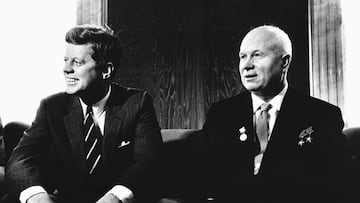What was the Cuban Missile Crisis and why is it important?
Over a fortnight-long period in late 1962, the US and the Soviet Union teetered on the brink of nuclear conflict amid a Cold War standoff described as "arguably the most perilous moment in world history".


Russian President Vladimir Putin caused global alarm last month by putting the country’s nuclear forces on “special alert”, a decision he said was motivated by “aggressive statements” from the West, amid widespread condemnation of Russia’s invasion of Ukraine.
It was a move described by UN Secretary General António Guterres as a “chilling development”, and was one that brought back terrifying memories from six decades ago, when, over a period of two weeks in October 1962, the Cuban Missile Crisis threatened to spark an all-out nuclear conflict between Cold War foes the United States and the Soviet Union.
How the 1962 Cuban Missile Crisis came about
A Caribbean island located just 90 miles off the southern tip of the US, Cuba had, much to American chagrin, become a communist state in 1959, when a revolution led by leftist lawyer Fidel Castro overthrew the US-backed dictator Fulgencio Batista. Castro quickly aligned himself with the USSR, the Soviets providing Cuba with military and economic aid.
In April 1961, just three months into the presidency of John F. Kennedy, a US-trained group of Cuban exiles attempted to remove Castro from power, invading the island at the Bay of Pigs - but the attack was a humiliating failure. Seven months on, in November 1961, President Kennedy then authorised Operation Mongoose, a CIA espionage and sabotage campaign designed to bring down the communist regime in the country.
With Cuba under threat from the US, Soviet leader Nikita Khruschev began shipping nuclear weapons to the island in late 1962, as a means of deterring American aggression against it.
Khruschev also saw the move as a way of extending the range of the Soviet Union’s nuclear arsenal and putting it on an even footing with the US, which had positioned weapons in European countries such as Turkey. According to the historian Serhii Plokhy, the author of the book Nuclear Folly: A History of the Cuban Missile Crisis, the Bay of Pigs fiasco had led Khruschev to view Kennedy as a weak president who would not stand in his way.
“Khruschev thought he was dealing with a really very inexperienced, indecisive leader who he could push around, and who could swallow the Soviet missiles being delivered to Cuba,” Plokhy told an interview with the History Extra Podcast.
See also:
First week of the Cuban Missile Crisis: before the world knew
On 14 October 1962, a U-2 US spy plane flew over Cuba, capturing images that confirmed the presence of ballistic missiles on a launching site on the island. Two days later, on 16 October, National Security Adviser George Bundy broke the news to the president.
The events that followed can be split into two parts: the week the world didn’t know about the crisis, and the week the world did know.
To avoid giving Khruschev the opportunity to react before the US had had time to consider its response, Kennedy and his advisers initially opted to keep the discovery secret. He set up a committee chiefly comprising national security officials, known as the ExComm, to decide what to do.
In daily ExComm meetings, early support for an air strike on Cuba gave way to a decision to initiate a naval blockade of the island - which Kennedy referred to as a “quarantine” - designed to prevent any further weapons from being shipped to the country.
Second week of the Cuban Missile Crisis: when the world knew
In a televised addresses on the evening of 22 October, Kennedy informed the nation, and the world, of the crisis in Cuba. Vowing to “halt and eliminate this clandestine, reckless, and provocative threat to world peace”, the president detailed his blockade plan, and declared that he was prepared to use military force if needed.
The Russians’ “sudden clandestine decision to station strategic weapons for the first time outside of Soviet soil is a deliberately provocative and unjustified change in the status quo, which cannot be accepted by this country”, Kennedy said.
He added: “All ships of any kind bound for Cuba, from whatever nation or port, will if found to contain cargoes of offensive weapons, be turned back.”
Kennedy also outlined the threat posed by the build-up of Soviet nuclear weapons on Cuba. "Several of [the launch sites] include medium-range ballistic missiles capable of carrying a nuclear warhead for a distance of more than 1,000 nautical miles," he said. "Each of these missiles, in short, is capable of striking Washington DC, the Panama Canal, Cape Canaveral, Mexico City, or any other city in the southeastern part of the United States, in Central America, or in the Caribbean area," he said.
"Additional sites not yet completed appear to be designed for intermediate range ballistic missiles, capable of travelling more than twice as far, and thus capable of striking most of the major cities in the western hemisphere, ranging as far north as Hudson’s Bay, Canada, and as far south as Lima, Peru."
Two days after Kennedy’s address, the Cuban Missile Crisis reached its tensest point, when it emerged that two Soviet ships and a submarine were approaching the blockade line. Would they attempt to force their way through, leading to a military confrontation and, potentially, a nuclear war? Thankfully, they did not. At the last minute, they relented, turning around and returning to the Soviet Union.
Reacting to the Soviets vessels’ 11th-hour about-turn, US Secretary of State Dean Rusk memorably said to Bundy: “We’re eyeball to eyeball and I think the other fellow just blinked.”
A deal is reached to end the crisis
Four days on from that close shave, Kennedy and Khruschev struck a deal to bring the crisis to a close, and the world breathed a sigh of relief. It was an agreement that came about in confusing circumstances, though.
On 26 October, Khruschev sent a letter to Kennedy offering to remove the missiles from Cuba on the condition that the US president promised not to invade the island. On 27 October, however, the Soviet leader sent a second communication, in which he changed the terms of the deal. He told Kennedy he would dismantle the weapons in Cuba if the US not only pledged not to invade Cuba, but also agreed to take its nuclear missiles out of Turkey.
It remains unclear why Khruschev made one offer, then another. After deliberating on how to respond to the double communication, Kennedy finally decided to reply only to the first letter, accepting the Soviet demand for a promise not to invade Cuba.
However, he also sent his brother, Attorney General Bobby Kennedy, to tell Soviet Ambassador Anatoly Dobrynin that the US would remove missiles from Turkey - but that this part of the deal had to be kept secret from the public.
"The most perilous moment in world history"
Related stories
On 28 October, Khruschev sent a letter agreeing to Kennedy’s response. The Cuban Missile Crisis was over. It had been a standoff that was “arguably the most perilous moment in world history”, the historian Mark J. White concludes in his book Missiles in Cuba: Kennedy, Khruschev, and the 1962 Crisis.
“Never before or since,” agrees fellow historian Sheldon Stern in his account The Week the World Stood Still: Inside the Secret Cuban Missile Crisis, “has the survival of human civilization been at stake in a few short weeks of dangerous deliberations.”

